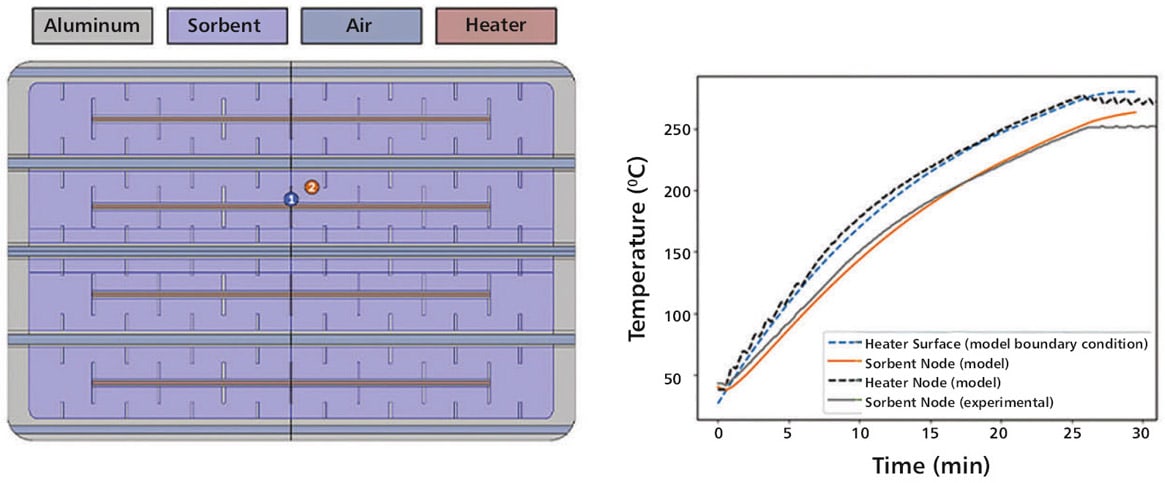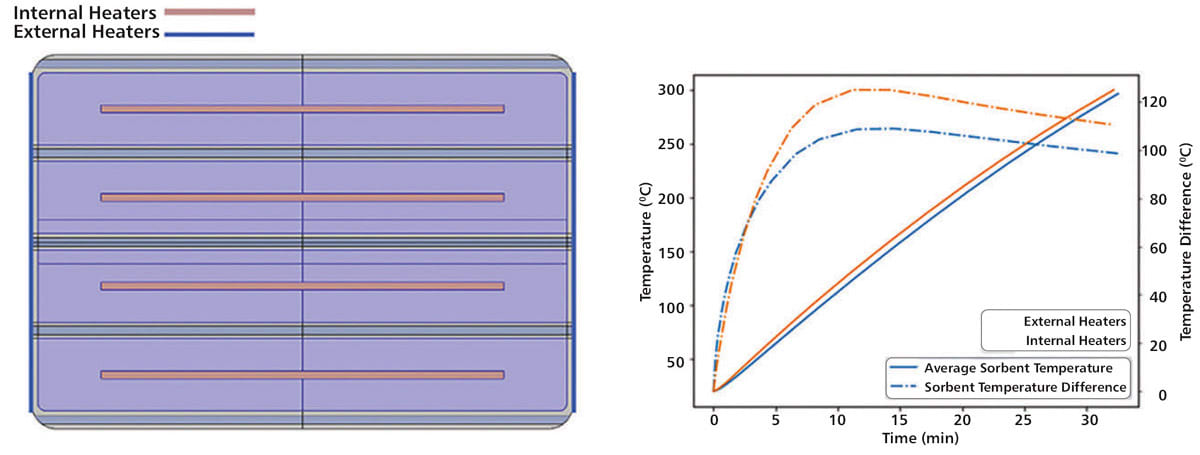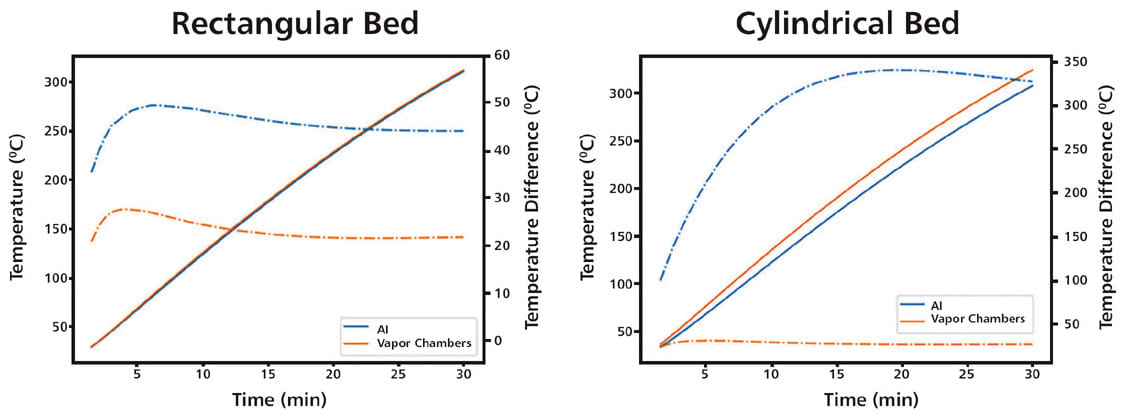
The International Space Station (ISS) is made livable in great part thanks to a system that captures and removes CO2 from the air. The workhorse inside that system is a compressor, which fulfills its CO2-capture duties, but at a cost: It is noisy and requires frequent maintenance. Engineers at NASA used modeling and simulation with experimental testing to analyze the next generation of compressor designs that get the job done more quietly, with fewer maintenance needs, and at lower fabrication cost.
Contaminant Removal Technology
Astronauts signing up to live and work on the ISS put a lot of trust in the engineers behind the contaminant removal technology that rids the cabin of CO2 ( Figure 1). “Currently, there is a system called the Carbon Dioxide Removal Assembly (CDRA),” explained Dr. Hannah Alpert, Aerospace Systems Engineer, NASA Ames Research Center.
“The CDRA absorbs CO2 to remove it from the cabin. Then that CO2 is sent to a Sabatier reactor [where] it is combined with hydrogen from the oxygen generation system to produce water.” That water is supplied to the astronauts for drinking. ( Figure 2) “We have this closed-loop system to keep the astronauts alive, but in order for the CO2 to work with the Sabatier reactor, it has to be at a higher pressure than what it is absorbed at, so we have a compressor in between the CDRA and the Sabatier reactor,” said Alpert. The CDRA is currently being upgraded to a new four-bed molecular steam system: the four-bed, CO 2 scrubber, or 4BCO2.

Alpert explained that the new system is meant to improve reliability and performance over the CDRA, which means that they are making various changes. For starters, the sorbent they were using for the CO2 capture needs to be replaced. Additionally, they have redesigned some of the components. “They switched from a rectangular to cylindrical bed, redesigned the heater core to better distribute the sorbent and eliminate the void spaces, and they are adding a filter to capture dust and new valves for longer operating lifetimes,” she outlined. That said, the basic functionality as far as how the 4BCO2 integrates with the compressor that Alpert’s team is working on is essentially the same as the current system.
Redesigning the Compressor
The current system features a mechanical compressor that is high mass and power, resulting in a lot of noise. The many mechanical rotating parts require frequent maintenance, and it is expensive to manufacture and run. “We are looking at some alternative technologies and one of our leading options is called an air-cooled temperature swing adsorption compressor (AC-TSAC),” said Alpert. “The AC-TSAC has lower mass and power requirements; it is less noisy; there are no rotating parts, so that will hopefully reduce the frequency of needing to replace parts; and then it is lower fabrication cost and easier to make.”
The AC-TSAC is a bed filled with minerals that capture CO2, called zeolite pellets, and it adsorbs CO2 more efficiently at room temperature. After pressurizing the CO2, it is delivered to the Sabatier reactor. To ensure that CO2 is constantly being supplied to the Sabatier reactor, the AC-TSAC is split into two beds. The team has developed one version of the AC-TSAC and now they are using thermal modeling to further improve on their designs.
Thermal Modeling Informs Design Choices
Alpert turned to the COMSOL Multiphysics® software to build models of the current AC-TSAC design. “We have found COMSOL® extremely useful over the past few years. One of the first projects I worked on when I joined NASA was modeling a heat flux gauge that flew on the Mars 2020 heat shield, and lately, I have been using the Optimization Module to reconstruct the surface heat flux on a heat shield,” she said.
For the compressor project, she built both 3D and 2D versions of the model and after concluding that both produced the same results for her purposes, she moved forward with the 2D model, since it took less time to run. Inside the AC-TSAC there are three shelves in the middle and zeolite pellets packed into the open spaces (Figure 3). Between each of the shelves are resistive heating plates to heat up the bed. The cooling channels allow air to flow through during the cooling stage.

Validating the Model
To validate the model, the team used temperature and power readings from two test campaigns that were done on the AC-TSAC. “The first one was a two-bed test for functionality at NASA Marshall. Then we did a more focused test campaign at NASA Ames, where we used one bed to isolate the exact properties more,” said Alpert.
During the NASA Marshall test, they placed resistance temperature detectors on the heater surface to measure the temperature. From there, they used the measured temperature as one of the boundary conditions of the model and ran the model to check that the modeled temperature matched the experimental data (Figure 4).

Next, the team performed the focused test at NASA Ames, which tested a single bed and collected experimental data from the heater surface and sorbent node. In this case, they used the measured power as input to their model and then they measured the temperatures at the heater node and sorbent node in the model. When they compared the model to the test results, they saw good overlap between the data.
Validated model in hand, Alpert and her team were ready to analyze how different design changes would affect the heating and heating rate of the compressor.
Design Trade Studies
As part of their search for the best new design, the team looked at specific design trade studies, including, but not limited to: internal vs. external heaters and aluminum bed vs. vapor chambers. The goal was to reach high temperature quickly and for the temperature to be uniform throughout the bed during ramp-up.
“The first design trade that we looked at was switching from internal heaters. Right now, there are internal heaters that are in the middle of the beds, and these are a potential point of failure. There are a lot of wires going into the bed and it is just a complex, messy, bundle of wires and heaters,” said Alpert. This led the team to wonder if it would be possible to move those heaters and if that would still heat up the sorbent quickly and uniformly.

Using Alpert’s model, they applied power to the internal and external heaters to compare the heating rate and uniformity (Figure 5). “Switching from internal to external heaters did not have a very big impact, which means that using external heaters rather than internal has the potential to improve or at least have the same amount of temperature uniformity of the sorbent while also reducing the complexity of the system,” she added.
In another study, the team analyzed the effect of switching from an aluminum bed to using vapor chambers (Figure 6). NASA works with external partners that manufacture and test the vapor chambers and perform high-fidelity modeling. The team modeled the vapor chambers using the material properties of aluminum, but at a much higher thermal conductivity, to get an idea of what the effects would be. Alpert noted that their main takeaway was “that when we switch to a vapor chamber bed instead of an aluminum bed, while the average sorbent temperature remains pretty much the same, using vapor chambers has the potential to improve the temperature uniformity of the sorbent.”

Performance Sensitivity Analyses
The NASA team also sought to increase the thermal conductivity of the sorbent itself. In the thermal model of the original AC-TSAC design, the team saw that increasing the thermal conductivity of the sorbent did not have much of an effect on the average sorbent temperature, but it did improve the temperature uniformity to a large degree. “That tells us that we are definitely going in the right direction and [as a result are] focusing a lot of our development efforts on that,” said Alpert.
Similarly, when the team increased the thermal conductivity in their model of a cylindrical bed with vapor chamber, the simulation results showed a large improvement in the temperature uniformity of the sorbent throughout the bed.
Combining Simulation with Experimental Testing
Alpert and her team successfully created a thermal model of the existing AC-TSAC and validated it against test data. Using the validated model, they were then able to determine what design parameters to change in order to get the desired results. Through simulation the team learned that external heaters reduce the system complexity and failure potential, vapor chambers have higher thermal conductivity and thereby improve the temperature uniformity of the sorbent, and they should continue to focus on increasing the sorbent thermal conductivity. The team will continue to validate the thermal model with experimental data and account for mechanisms like heat loss.
COMSOL and COMSOL Multiphysics are registered trademarks of COMSOL AB.
This article was written by Fanny Griesmer, Chief Operating Officer, COMSOL (Burlington, MA). This is an abridged version of the article published on COMSOL’s website. For more information, visit here .

